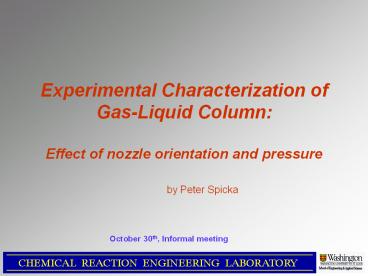Gas-Liquid Columns: Experimental Characterization and CFD Simulations
Title:
Gas-Liquid Columns: Experimental Characterization and CFD Simulations
Description:
Experimental Characterization of Gas-Liquid Column: Effect of nozzle orientation and pressure by Peter Spicka October 30th, Informal meeting CHEMICAL REACTION ... –
Number of Views:92
Avg rating:3.0/5.0
Title: Gas-Liquid Columns: Experimental Characterization and CFD Simulations
1
Experimental Characterization of Gas-Liquid
Column Effect of nozzle orientation and
pressure by Peter Spicka
October 30th, Informal meeting
2
Objective
- Study the sparger nozzle orientation effect on
gas hold-up, liquid velocity and turbulence in
gas-liquid column
Motivation
- Only few data, i.e. liquid velocity and gas
holdup, available in the literature for
churn-turbulent flow regime - CARPT and CT techniques allow relatively accurate
acquisition of needed data - Different pressures and UGS can be covered
- Additional experimental database for CFD
simulations can be created
3
Experiment
- 6.375 stainless steel column
- Cross-sparger, two nozzle orientations facing
upward and downward - Air-water system
- Dynamic height maintained at 11 D
- Pressure 1 bar and 4 bars
- UGS 5 cm/s (only CT) and 20 cm/s
- CARPT setup
- Typical setup, 30 detectors
- Only photo peak acquisition
- 50 Hz sampling frequency
- CT setup
- 5 detectors, 7 projections per view
- 4 axial levels 2.5D 3.5D 5.5D and 9D
- 20 Hz sampling frequency
4
Detector alignment and calibration
CT CARPT
Typical energy spectrum
Typical calibration curve
- CT
- photopeak at 650 mV
- acquisition threshold was set to 580 mV
- CARPT calibration
- relatively small number of counts compared to
previous experiments Þ weak tracer particle - Calibration positions reconstructed with accuracy
1 cm
Reconstructed calibration positions
Detector Alignment
5
Accuracy of the experiments
- Source of errors for CT data
- reconstruction algorithm disregards of the
non-linear nature of the Lambert-Beer law - projection time t17 s may be insufficient for
reliable time averaging - CARPT data
- gas-holdup fluctuations
- natural fluctuations in radiation intensity
Mass balance for liquid phase
Liquid net inflow, based on the exp. data, is
calculated as
and its relative value (with respect to gas net
inflow)
Values of eL for different flow conditions
6
Minimum count threshold Effect on instantaneous
particle positions
Threshold25 Threshold18 Thresh
old11
- Strong influence of the minimum count threshold
on particle occurrence Þ velocities computed in
near the column walls can be less accurate
- Present Data
- Very high count threshold was used for the CARP
data Þ more than 50 points rejected!
Note only 5 fraction of the total number of
points is shown in the charts
7
CT Results Effect of Nozzle Orientation- Global
View
- Configuration with nozzles facing upward provides
increased hold-up Þ smaller bubbles? - Similar behavior was found for all the studied
regimes
Gas holdup at UGS 20 cm/s and p 1 bar
nozzles facing downward nozzles
facing upward
Overall gas holdup
8
CT Results Effect of Nozzle Orientation and
Pressure
Gas holdup profiles UGS5 cm/s
UGS20 cm/s
- Nozzle orientation
- particularly pronounced at high pressure and high
UGS in the sparger zone - diminishes with axial position
- Pressure
- Typical increase of gas holdup magnitude
9
Axial velocity profiles Radial
velocity profiles
CARPT Results Liquid velocity
- Steeper velocity profiles observed at high
pressure Þ higher bubble momentum - However, effect of nozzle orientation on liquid
velocity is visible only at near-sparger region
10
CARPT Results Turbulent kinetic energy
Nozzles facing down Nozzles facing up p 4
bars
- Turbulent kinetic energy is higher for nozzles
pointing upward - Similarity with gas holdup maps Þ bubble-induced
turbulence
11
CARPT Results Reynolds stresses
- uxux are approximately 2.5 x higher than urur
and they are weakly coupled - Magnitude of uxux is comparable with the
corresponding mean velocities - Highly anisotropic flow !
12
Concluding Remarks
- Nozzle orientation
- Significant effect on gas holdup and turbulent
kinetic energy mainly near the column bottom - More pronounced at high UGS and high pressure
- Effect on liquid velocity profiles is less
significant - Uncertainty in magnitude of turbulent parameters
due to gas holdup fluctuations
Outlook for future
- Experiment
- Elimination of gas holdup fluctuations from CARPT
data - CARPT reconstruction with improved parameters
- Check for data reproducibility
- CFD
- Examination of nozzle orientation effect in
churn-turbulent regime































